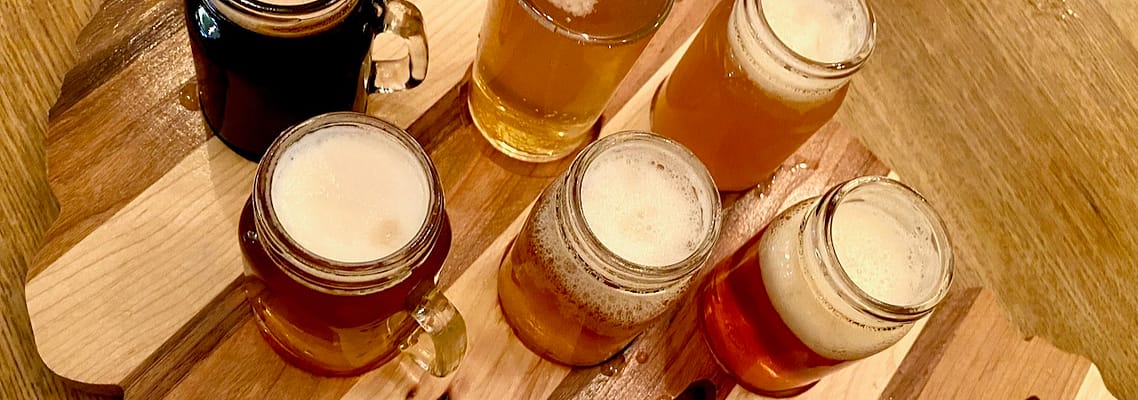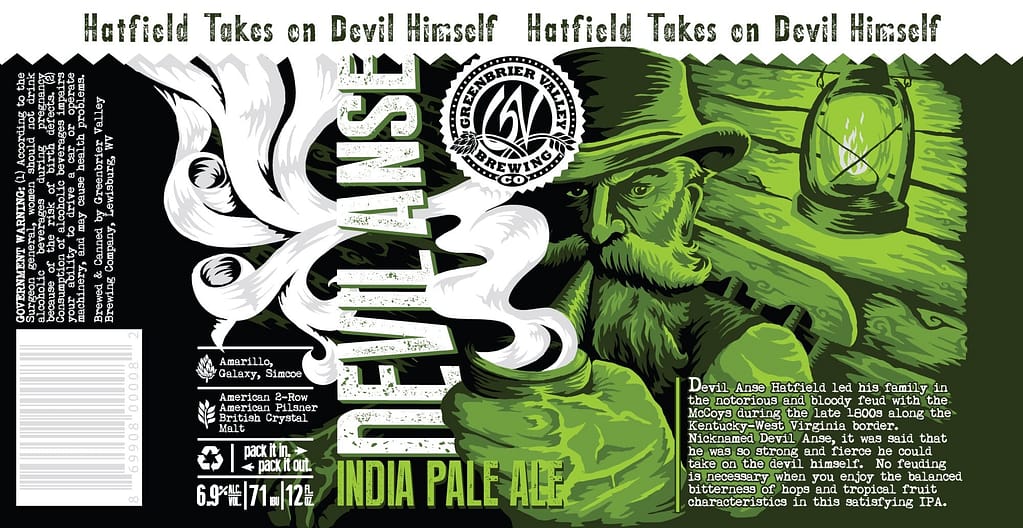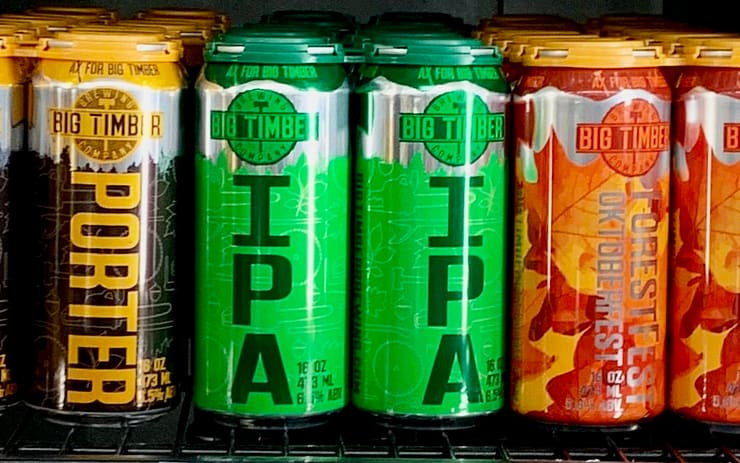
Celebrate WV IPAs on IPA Day
August 4, 2022
India Pale Ales—or IPA as we love to call them—as a group are the most popular beer category in American craft beer today. Beginning many. many ago as simply a bit stronger and more hop-bittered version of an English pale ale or bitter, American IPAs have moved well beyond that today. And West Virginia brewers are right in the mix of those expanding the IPA envelope.
As we celebrate national IPA Day on August 4th, this most experimented-with beer style is pretty much impossible to easily define. It’s probably best to say IPA is still primarily a beer style that features hops more so than other beer styles. These hops may be expressed as adding solid bitterness, aroma and flavor, or they may be used in a different way to create aromas and flavors without adding much bitterness. Many IPAs are not particularly bitter these days.

HOPS
Hops for IPAs used to be added almost exclusively during the boil phase of the beer production, but not anymore. Today, more hops are added during the later stages of beer production, including to the kettle after flame-out, in the whirlpool, and in the fermentation tank (dry-hopping). These later additions of hop introduction push flavor and aroma over bitterness. Adding hops in kettle during boiling extracts more bitterness than flavor. In recent years, many new hop varieties have been developed for their flavor and aroma rather than their bitterness.
MALT
Another common feature of most IPAs is the use of pale malt as the backbone of the beer, though other types of malts and even other grains are commonly added to the base. The beers range from bone dry (Brut IPA) to mildly sweet to sugary (some Milkshake IPAs). American brewers have pretty much thrown out the style guidelines and altered this beer in a plethora of directions.
YEAST
Yeast used to ferment an American IPA varies depending on what version of an IPA one desires to brew. Probably the most popular for non-hazy IPAs is a clean quick fermenting yeast strain (and its variants) popularized in California by Sierra Nevada. Called the Chico yeast (Wyeast 1056, White Labs WLP001, SafAle US-05) this west coast yeast works great in standard American IPAs. For hazy styles, however, brewers use different yeasts often derived from certain English yeasts, which do not settle out so well from the liquid and help keep the beer hazy and also give more fruity esters in the aroma.

COLOR
IPAs used to be bright amber beers, sometimes leaning toward copper colors. No more. Now, IPAs take on hues from lighter golden to amber to black. Flavored or Milkshake IPAs may even be pink or lilac. Anything goes in the 2020s.
ALCOHOL
Historically, standard strength IPAs (single IPAs) ran from 5% to 7.5%, though today, with American beer ABV creep, it’s hard to find an IPA lower than 6.0%. Double IPAs today are most commonly in the 7.5% to 8.5% ABV range, but can go higher. IPAs stronger than that today are most often labeled Triple IPA or Imperials. You’ll occasionally find beer labeled IPA that is as strong as 11% or even 12% ABV.
If you can dream it, you can brew it

It might be best to see today’s IPA as simply a base idea that develops in any direction a brewer’s imagination leads them. You could build a strong case that IPAs are America’s most creative and unique beer style. Don’t try to define it; just enjoy it.
West Virginia IPAs in 2022
The following list, while surely not complete, contains the most common IPA variants you’ll find in the market, along with a few rarer ones. The list includes examples of West Virginia brewed IPAs that fit the version.
English IPA – Characterized by the use of earthy and herbal English hop varieties and pale English malts such as Maris Otter, which produce a biscuity, malty aroma and malty, often mildly nutty flavor. Uses a yeast that produces fruity esters. Standard in strength.
Commercial Example: hard to find one labeled as such in WV. Closest are Best Bitters and ESBs.
American IPA – The base is pale barley malt with a portion of lightly toasted or specialties for color, taste and additional body. Ranges from lighter to moderately rich malt flavors. Hop flavors in it may range from fruity to citrusy to piney/resiny. Bitterness ranges from mild to strong. Most often the days uses a neutral yeast that does not push the fruity flavors and typically lands on the dry side. Commercial Example: Big Timber IPA, Greenbrier Valley Devil Anse IPA, Bad Shepherd Loud, Mountain State Seneca IPA, Screech Owl Hoo’s Your Daddy, The Peddler Fist Bump; Chestnut Brew Works Your Best Hoption, Abolitionist Alpha Mayle, Stumptown Bewildered Hippie
Mid Coast IPA – A nicely balanced, highly drinkable style developed by brewers in the mid-continent which is less bitter than West Coast IPAs and often featured the Centennial hop variety. Commercial Example: Bell’s Two Hearted Ale, Weathered Ground Tallahatchie, High Ground Mandatory Fun
West Coast IPA – An American IPA featuring piney, resiny hop aroma and flavors and high bitterness. Most often dry with a moderate body.
Commercial Example: Stone IPA, Weathered Ground That Old West Coast IPA
New England IPA – A style developed to be less bitter but heavily dry-hopped to give it loads of hop flavor without the corresponding bitterness. Maybe a bit sweet or dry. Creamier mouthfeel. Light haze to fully milky appearance.
Commercial Example: Stumptown Ales Six Legged Frog, Big Timber Overcast & Jazzy Juice IPA; High Ground Druid Fluid, The Peddler Silt Sucker
Red IPA – made with darker toasted malts added that give a reddish color to the beer. Moderately bitter. Moderate body. Often more malty flavor than standard American IPA.
Commercial Example: The Peddler Uncle Bubby
Black IPA – very dark brown to black in color from the addition of dark roasted specialty malts. Usually quite dry. Generally quite bitter and a bit roasty.
Commercial Example: Greenbrier Valley Mothman
White IPA – picks up a whiter color from added wheat grain. Often a bit lighter in body and more soft in the mouthfeel than Standard IPA. Hopping varies from moderate to heavy. Bitterness also may cover a wide range, but is most often moderate. Often gets some fruity esters from use of a Belgian yeast. May contain other flavoring ingredients that lean toward orange citrus.
Commercial Example: Abolitionist Belgian Haze, Weathered Ground Zestivus, Greenbrier Valley Grafton Monster
Double IPA – made with an extra portion of malt that provides the extra sugar to make extra alcohol and provide more flavor. Typically raises the ABV by 2.0 or more percent. Richer, fuller, and usually more hoppy than Standard. Most any IPA style on this list can be Doubled, for example a Double New England IPA or a Double West Coast IPA.
Commercial Example: Short Story Two for the Show, Stumptown Ales Multiple Hopgasms, Parkersburg Brewing POW Daze; Weathered Ground More Haggard Than Haggard
Imperial IPA – Another name for Double or Triple IPA.
Triple IPA – An IPA with a very high alcohol content, often 9 to 11 percent ABV.
Commercial Example: Big Timber Overgrowth IPA, Stumptown Big Boy Pants
Session IPA – an IPA with a lower ABV by using less grain than a Standard IPA. Lighter, thinner body d. May be quite hoppy. Bitterness covers wide range from low to moderate. About any of the other IPAs on this list may be made in a Session (low ABV) version.
Commercial Example: Big Timber Hatchet IPA, Weathered Ground Kinda Haggard IPA
Brut IPA – An IPA characterized by being bone dry. Clean fermentation. Very low maltiness, May be quite hoppy.
Commercial Example: Big Timber Lil Brutti; Chestnut Brew Works Brockway Brute and Grape Expectations
Rye IPA – An IPA with a dose of rye malt in the grain bill. Giving a spicier background flavor.
Commercial Example: Weathered Ground More Scrappy Than Scrappy

Juicy IPA – An IPA dry-hopped with newer juicy, fruity hop varieties to accentuate the juicy fruity citrus or tropical hop flavors. Moderate to low bitterness.
Commercial Example: Stumptown Ales Holy Citra. Parkersburg Brewing Citrus Tsunami
Hazy Juicy IPA – A juicy style IPA produced in a manner the keeps it cloudy. Often uses an English-style yeast that produces more fruity esters and stays in suspension to keep the beer cloudy. To the base pale malt may added other grains like oats or wheat flour to help with the haziness and creamier mouthfeel.
Commercial Example: Short Story Sideways Glance, Weathered Ground Stop and Smell the Citrus.
Farmhouse IPA – An IPA that is fermented with a Belgian saison, wild or similar yeast to give it a little phenolic or barnyard character.
Commercial Example: Weathered Ground Puney Creek IPA; Abolitionist Farmhouse IPA
Brett IPA – An IPA fermented with Brett (bretanomyces) strain of yeast. Typically pretty dried out with a bit of fruity or funky flavor from the yeast.
Commercial Example: Abolitionist Pale the Funky
Single Hop IPA – These are IPAs that feature a single hop variety, most if not exclusively applied as a late addition or dry-hop.
Commercial Example: Weathered Ground Haggard IPA (El Dorado hop), Stumptown Holy Mosaic or Holy Citra
SMASH IPA – This stands for the use of a single malt and a single hop in the IPA’s production.
Commercial Example: The Peddler Smash Bros.
Milkshake IPA – A thicker creamier beer. Cloudy and flavored up. Contains lactose. Can be any milk shake-ish flavor combination. Not bitter. Most are on the sweet side.
Commercial Example: High Ground Weird Handshakes, Weathered Ground Worth Two Licks
Flavored IPA – A standard IPA base flavored with just about any fruit, spice, vegetable, coffee, chocolate, or other flavor that takes over from the base IPA. Typically not very bitter. Color varies by flavoring added.
Commercial Example: Morgantown Brewing Listen To Slayer, Weathered Ground Pineapple Haggard
Sour IPA – Any other IPA that is soured, typically with a lactobacillus culture. Often flavored.
Commercial Example: High Ground Aw Jeez, Weathered Ground Worth
A Tang, Big Timber Sourlicious, Abolitionist Mellow Amarillo
Cold IPA – The most recent IPA variant to begin catching on is the Cold IPA. This IPA is fermented at lower temperatures than normal—much more like the temps used to ferment lagers. Brewers even use lager yeast in combination with their normal ale yeast to make these beers. The result is a cleaner, crisper IPA that is often hopped like a traditional German lager with its floral, earthy aromas and flavors and moderate bitterness.


